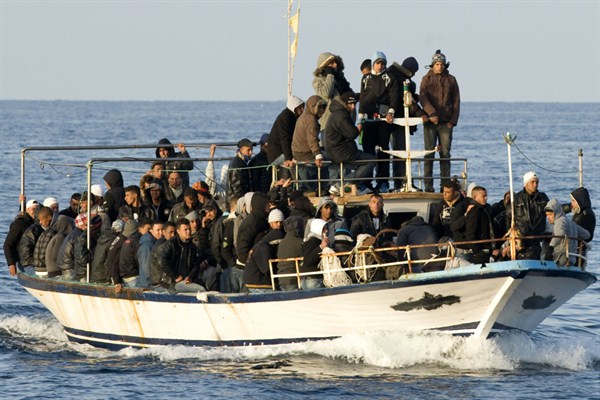The plight of migrants and refugees has made headlines around the world in recent months. Despite the globalized economy, governments remain stubborn about the movement of human beings across national borders. This report covers ongoing migration crises from the Mediterranean to Africa to Southeast Asia.
Thousands of African and Middle Eastern migrants fleeing to Europe in unsafe boats have drowned in the Mediterranean in high-profile incidents this year. The European Union has drawn much criticism for its inability to prevent these tragedies.
Not the Usual Suspects: No Easy Answers for EU Migrant Crisis
In May, Ellen Laipson cautioned critics of the EU that the politics of handling refugee flows are more complicated than simplistic moralizing would suggest. The media scrutiny “may create more public awareness, but that alone will not lead to more efficient systems to rescue and eventually accommodate the migrants.”
The Mediterranean migrant crisis is not new. In 2013, Liza Schuster argued that the EU bears responsibility for the conditions that cause migrants to risk the journey in the first place. “The deaths will continue unabated until the EU opens up in the short term to those in need of protection as well as work, and in the long term addresses the inequality and injustice that drives people to leave their homes,” she wrote.
In March, Maria Savel discussed one possible EU policy intervention: overseas asylum centers to process irregular migrants. One hurdle is that a plan backed by the EU would require burden-sharing among countries that don’t border the Mediterranean, many of which are confronting anti-immigrant backlashes at home.
Last December, Richard Gowan examined the security dimensions of the EU’s migration crisis. “If the bloc’s members had taken earlier and firmer action in cases like Syria or sent more peacekeepers to fragile states such as Mali,” he wrote, “they might have averted the disaster on their southern shores.”
Africa:
While African migration is often cast in terms of European policies, African states also struggle with refugees, not only as conduit countries but also as destinations.
In a May feature, Katharina Natter detailed how Morocco, a crucial transit country for African migrants en route to Europe, has also become a destination in its own right. Its policy responses have been confusing, as humane constitutional reforms are followed by violent police crackdowns on refugee camps.
In April, Frida Ghitis looked at Eritrea, “a small country in East Africa that is neither at war nor suffering from a natural disaster” and yet was one of the major sources of the refugees who drowned in the Mediterranean that month. “In fact,” she wrote, “people are fleeing Eritrea, with a population of just 6 million, at a greater rate than almost any other country. In 2014, more Eritreans sought refuge in Europe than people from any other state besides Syria, and the numbers are growing.”
One major non-European destination country for African migrants has been South Africa, whose relatively strong economy has drawn large numbers of people from Zimbabwe and other neighboring countries. In a feature last year, James Hamill looked at how South Africa’s increasingly harsh policies toward these migrants were hurting its standing across Africa.
This April, the situation in South Africa grew worse after a series of xenophobic attacks on African migrants, forcing President Jacob Zuma to apologize to multiple African leaders. David Klion described how Zuma and other powerful domestic forces have stoked anti-immigrant sentiment, even as they now scramble to respond to the violence.
Asia:
Southeast Asia is another place where migration issues have proved divisive, as neither wealthy Australia nor the region’s poorer countries have been eager to take in refugee populations.
In 2013, Khalid Koser described how Australia’s then-center-left government, led by Prime Minister Kevin Rudd, embraced anti-asylum policies. “Rudd, the internationalist turned nationalist, has jeopardized Australia’s global reputation as a champion of human rights and a model of managed migration,” he wrote.
Despite pandering to anti-immigrant sentiment, Rudd’s party lost control of Parliament, and Australia’s conservative Prime Minister Tony Abbott has continued the same approach. Last December, Matthew J. Gibney took a critical look at Abbott’s plan to permanently resettle refugees in Cambodia.
Meanwhile, the latest crisis in the region concerns the Muslim Rohingya minority in Myanmar, which faces abuse from the government there and indifference from neighboring countries like Thailand, Malaysia and Indonesia. This month, Gibney discussed the plight of the Rohingya, arguing that “The only answer lies in reforms in Myanmar that incorporate the Rohingya as full and respected members of society.”
Related

